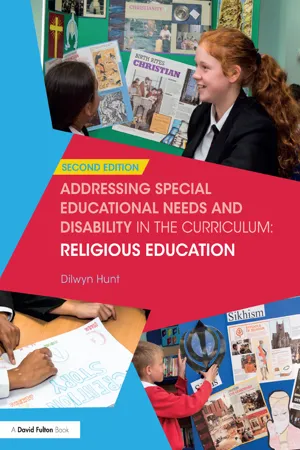
Addressing Special Educational Needs and Disability in the Curriculum: Religious Education
- 168 pages
- English
- ePUB (mobile friendly)
- Available on iOS & Android
Addressing Special Educational Needs and Disability in the Curriculum: Religious Education
About this book
The SEND Code of Practice (2015) reinforced the requirement that all teachers must meet the needs of all learners. This topical book provides practical, tried and tested strategies and resources that will support teachers in making RE lessons accessible and interesting for all pupils, including those with special needs. The author draws on a wealth of experience to share his understanding of special educational needs and disabilities and show how the RE teacher can reduce or remove any barriers to learning.
Offering strategies that are specific to the context of RE teaching, this book will enable teachers to:
- create a supportive environment which maximises learning opportunities;
- plan the classroom layout and display to enhance learning;
- help students of all levels to gain confidence in their reading and writing ability;
- stimulate discussion and develop thinking skills through using stimuli such as religious art, music, artefacts and films;
- successfully train and fully use the support of their teaching assistants.
An invaluable tool for continuing professional development, this text will be essential for teachers (and their teaching assistants) seeking guidance specific to teaching RE to all pupils, regardless of their individual needs. This book will also be of interest to SENCOs, senior management teams and ITT providers.
In addition to free online resources, a range of appendices provide RE teachers with a variety of writing frames and activity sheets to support effective teaching. This is an essential tool for RE teachers and teaching assistants, and will help to deliver successful, inclusive lessons for all pupils.
Frequently asked questions
- Essential is ideal for learners and professionals who enjoy exploring a wide range of subjects. Access the Essential Library with 800,000+ trusted titles and best-sellers across business, personal growth, and the humanities. Includes unlimited reading time and Standard Read Aloud voice.
- Complete: Perfect for advanced learners and researchers needing full, unrestricted access. Unlock 1.4M+ books across hundreds of subjects, including academic and specialized titles. The Complete Plan also includes advanced features like Premium Read Aloud and Research Assistant.
Please note we cannot support devices running on iOS 13 and Android 7 or earlier. Learn more about using the app.
Information
1 Meeting special educational needs and disabilities
Definition of SEND
Whole-school ethos
| Communication and interaction | Cognition and learning | Social, emotional and mental health difficulties | Sensory and/or physical needs |
|---|---|---|---|
| Speech, language and communication needs (SLCN) Asperger’s Syndrome and Autism (ASD) | Specific learning difficulties (SpLD) Moderate learning difficulties (MLD) Severe learning difficulties (SLD) Profound and multiple learning difficulties (PMLD) | Mental health difficulties such as anxiety or depression, self-harming, substance abuse or eating disorders Attention deficit disorders, attention deficit hyperactivity disorder or attachment disorder | Vision impairment (VI) Hearing impairment (HI) Multi-sensory impairment (MSI) Physical disability (PD) |
Policy into practice
Excellent classroom provision
Table of contents
- Cover
- Half Title
- Title Page
- Copyright Page
- Table of Contents
- List of appendices
- Series authors
- A few words from the series editor
- Acknowledgements
- Introduction
- 1 Meeting special educational needs and disabilities: your responsibility
- 2 The inclusive religious education classroom
- 3 Teaching and learning
- 4 Monitoring and assessment
- 5 Managing support
- 6 Real pupils in real classrooms
- Appendices
- References and useful resources
- Index